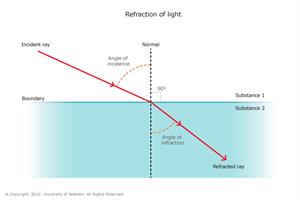PDF chapter test TRY NOW
The refraction of light in a medium depends on the speed of light in that medium. Therefore, when the speed of light in a medium is more, the bending is less, and when the speed of light is less, the bending is more.

The amount of refraction of light in a medium is denoted by a term known as the refractive index of the medium, which is the ratio of the speed of light in the air to the speed of light in that particular medium. It is also known as the absolute refractive index, and it is denoted by the Greek letter ‘μ’ (pronounced as ‘mew’).
Refractive index is a ratio of two similar quantities (speed), and so, it has no unit.
Since the speed of light in any medium is less than its speed in the air, the refractive index of any transparent medium is always greater than 1.
Refractive indices of some common substances are given in the table.
| Substances | Refractive Index |
| Air | 1.0 |
| Water | 1.33 |
| Ether | 1.36 |
| Kerosene | 1.41 |
| Ordinary Glass | 1.5 |
| Quartz | 1.56 |
| Diamond | 2.41 |
In general, the refractive index of one medium with respect to another medium is given by the ratio of their absolute refractive indices.
Thus, the refractive index of one medium with respect to another medium is also given by the ratio of the speed of light in the first medium to its speed in the second medium.
Reference:
https://www.sciencelearn.org.nz/images/49-refraction-of-light-in-water
